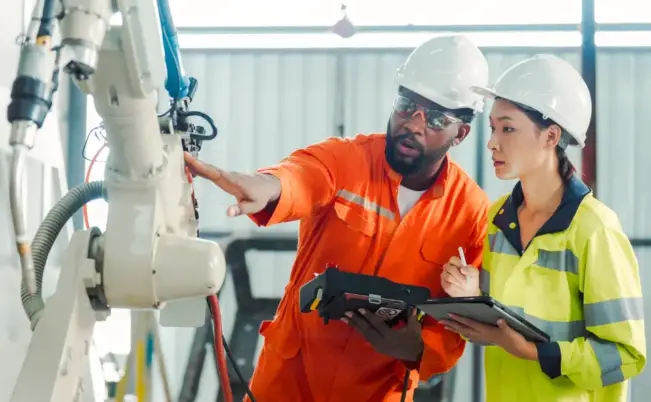CPTC helps make collective impact through Good Jobs, Great Cities Academy
By Jean Borst
When Tacoma was tapped as one of only 16 U.S. cities selected for the Good Jobs, Great Cities Academy last year, it was only natural that Clover Park Technical College be a part of the collaboration to build a sustainable green workforce strategy for the region.
The one-year initiative offered through the National League of Cities (NLC) and U.S. Department of Labor (DOL) helps cities fast-track their efforts to design, develop and launch workforce initiatives that lead to good jobs – especially for residents from historically underserved and underrepresented communities.
CPTC President Dr. Joyce Loveday and Vice President of Instruction Dr. Tom Broxson are part of the cohort led by City of Tacoma Mayor Victoria Woodards, which includes employers, workforce and education partners, labor and community organizations. Together, the group is working to find innovative solutions that upskill and reskill workers into jobs in infrastructure, clean energy and advanced manufacturing.
“Participating in the Academy and being part of this team aligns perfectly with our mission to educate tomorrow’s workforce,” Loveday said. “Our goal is to build a blueprint for our region to connect people to quality jobs and employers to skilled workers.”

Power in numbers
“The pathways to jobs from other careers or from K-12 aren’t always clear. This is an opportunity to create a collective-impact model for the city and region that will expand workforce pathways, specifically around advanced manufacturing and construction jobs,” Broxson said. “We’re at a unique moment here in Pierce County. Everyone is realizing the challenges at the same time, and they’re much bigger than one institution.”
“Combining and aligning our strengths is the only way we will meet the growing demand for the green workforce,” said WorkForce Central Executive Officer Katie Condit, a key member of the Good Jobs, Great Cities Academy cohort. “Together, we can enact efficiencies that will allow all of us to serve more students and streamline processes so students aren’t thwarted as they try to advance in their education and training.”
Since the Academy began last summer, the Tacoma coalition has received intensive coaching and support from the NLC and DOL. That includes connecting the group with funding resources to help prepare the regional workforce for what’s happening now and what’s ahead. As a collective, the group is now applying for grants that are likely much larger than what just one institution would be able to land.
“With $1.8 trillion in federal funding beginning to come on line through spending bills, we all realize that this is a once-in-a-lifetime opportunity to expand the workforce significantly to meet current and future demand,” Broxson said. “When you look at projects like the Port’s plan for electrification and developing a clean hydrogen ecosystem, we simply don’t have the workforce capacity to build or run those undertakings.”
Off to a strong start
In less than a year, the coalition has already made substantial strides, including:
- Doubling pre-apprenticeship capacity in construction skilled trades and manufacturing in Pierce County through partnerships with the Palmer Pathways Pre-Apprenticeship program and AJAC (Aerospace Joint Apprenticeship Committee) Advanced Manufacturing Apprenticeships. CPTC has been instrumental in applying credits to Palmer Pathways young adults while hosting the program on its campus.
- Increasing capacity for employer connections to CPTC and Bates Technical College students who are moving into the job market. That includes increased wraparound support for students to support them to completion, and embedded manufacturing training through AJAC for high school students as an onramp pathway.
- Hosting the first-ever Green Jobs and Pathways Summit on the CPTC campus. The Summit brought together nearly 200 industry and education representatives in an effort to build a better understanding among green jobs sector stakeholders to more intentionally grow and bridge pathways. Broad conversations during the Summit became the foundation of a 10-year Green Jobs Workforce Plan for the region.
“Our hope for the year was to develop a strategic plan for this work,” Condit said. “We’ve far surpassed that goal by beginning to grow evidence-based partnerships and strategies.”
Just the beginning
The Academy officially ends in August, but the work in Tacoma-Pierce County will continue. The coalition has formulated a four-point strategy for the next few years, which includes:
- Revamping City of Tacoma policy, to further embed and adopt quality green jobs principles and apprenticeships.
- Aligning K-12, post-secondary and pre-apprenticeship pathways with workforce needs.
- Getting the word out through a City of Tacoma Pathways campaign, including core messages that this is a center for green job growth and good living wage jobs, and where training pathways are abundant and easily accessible.
- Ensuring efforts are geographically focused.
That last item is particularly critical. Even before the Good Jobs, Great Cities Academy, CPTC had been working to identify historically underserved parts of Pierce County where there was a need for what the college offers. When the cohort began its work, Tacoma’s Eastside became the focus.
“Our strategy is to increase transportation accessibility and training capacity in that area,” Broxson said. “For someone living in the Eastside neighborhood, it takes two hours to make the five-mile trip to CPTC.”
With no high school, college or bus service in the area, the coalition is actively pursuing a training center for green jobs on the Eastside. The group is also looking for a location for a 24/7 child care center to help eliminate one of the biggest barriers to employment.
“We have a crackerjack team bent on seeing things change,” Broxson said. “Being a part of this kind of collaboration is exactly where the college needs to be right now. We have an opportunity to make lasting change in Tacoma and Pierce County.”